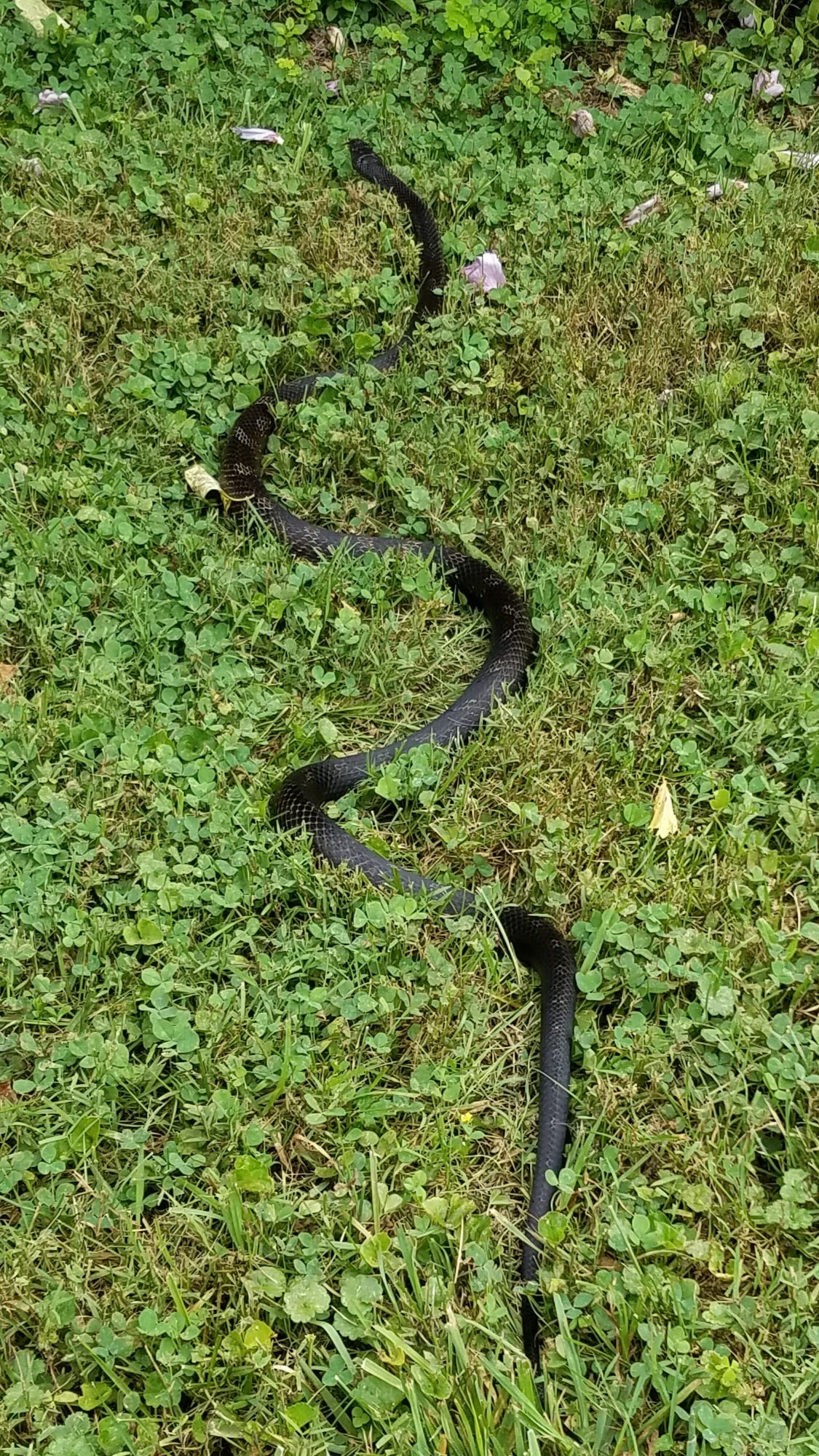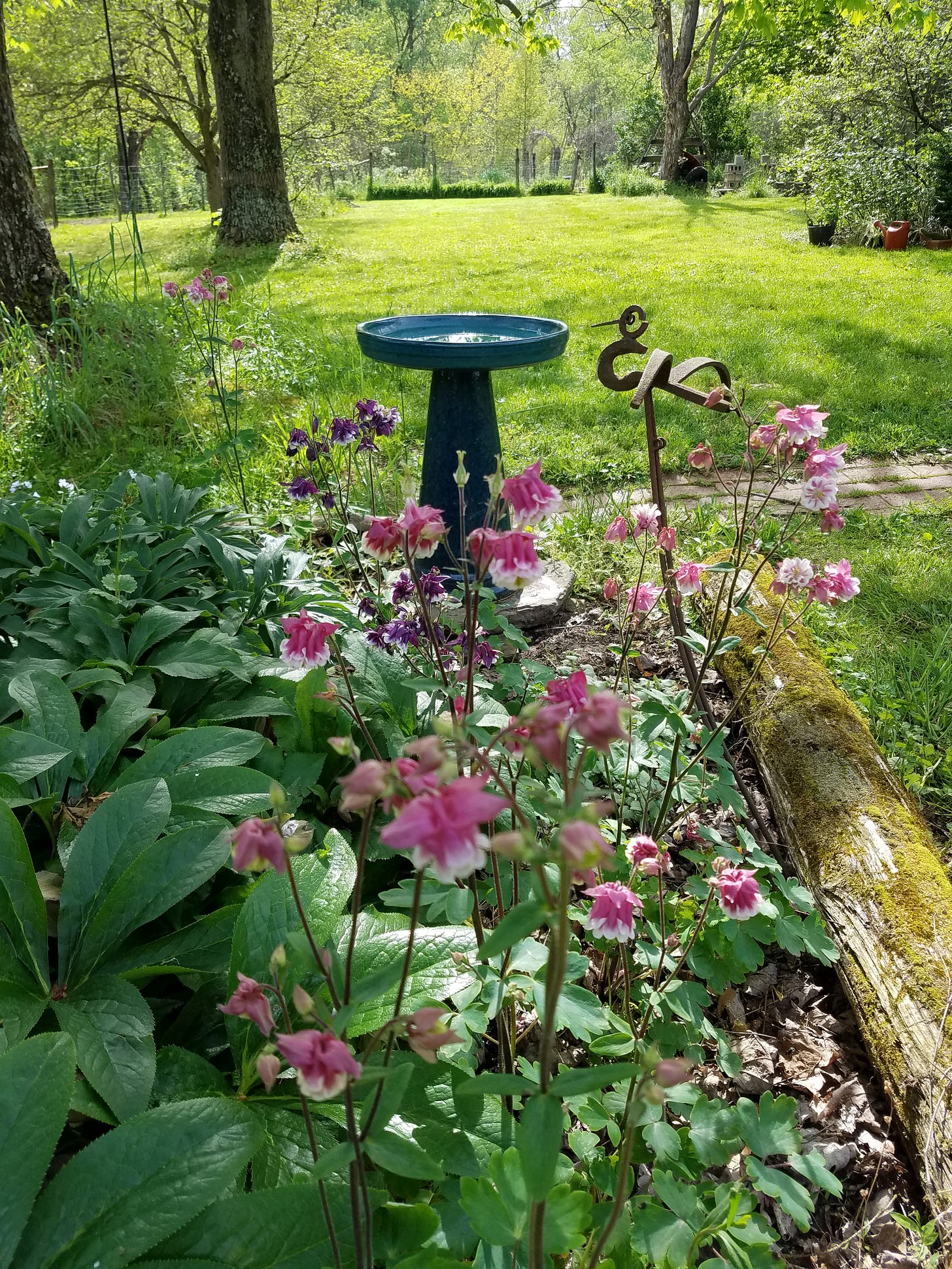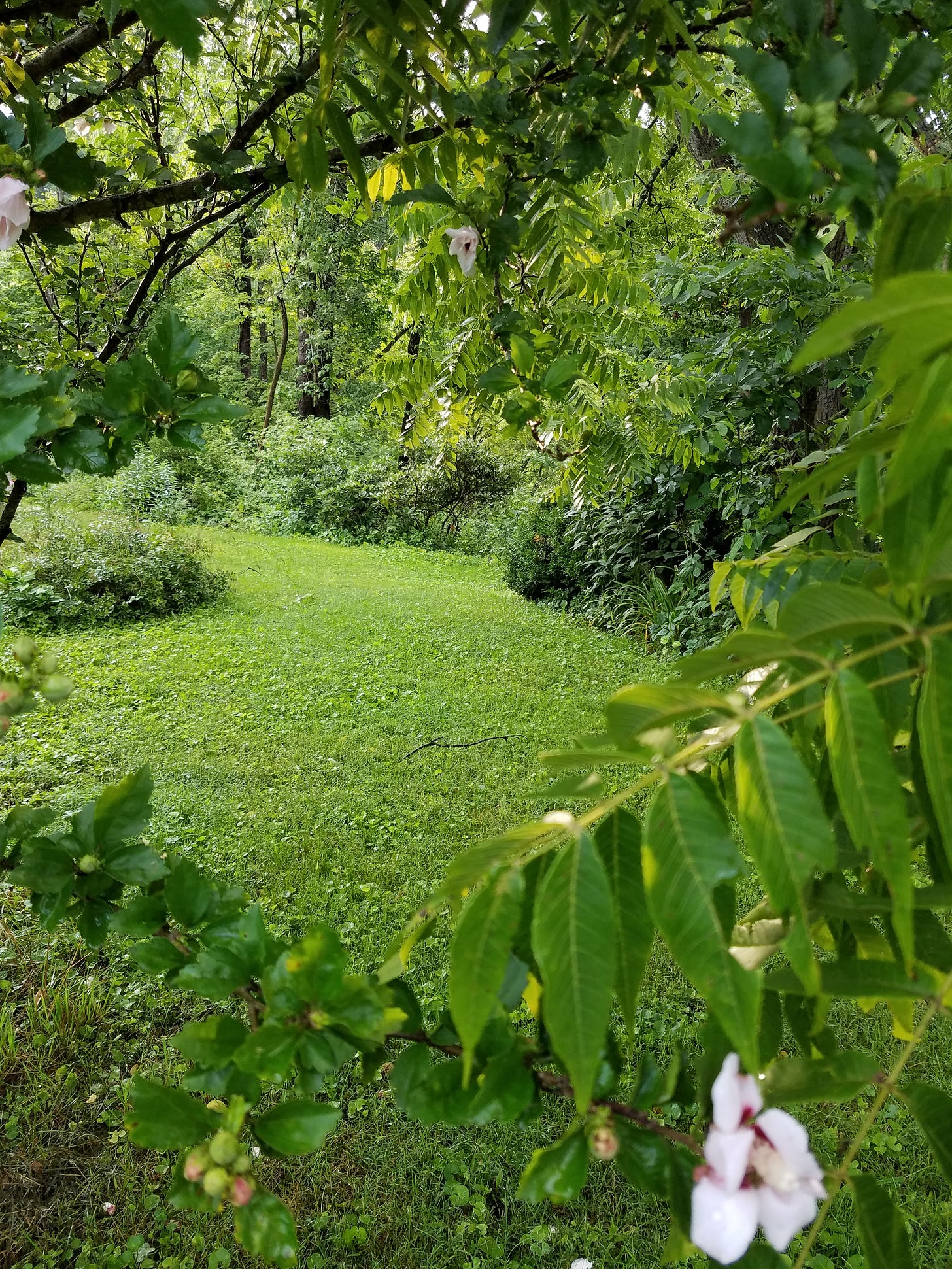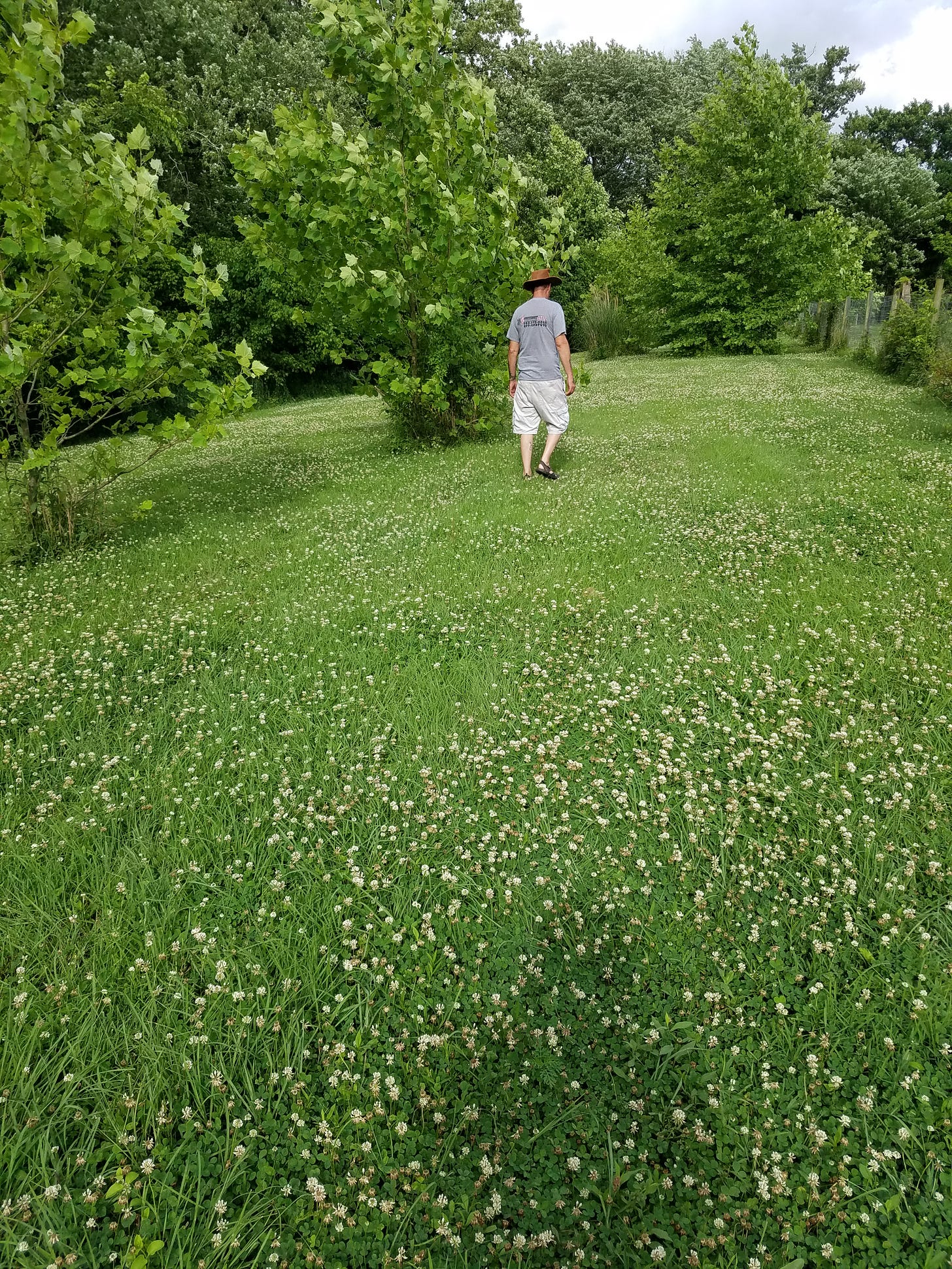I've written about my lawn before, but it was over two years ago, before my migration to Substack. Given that we're deep into the long, dark tea-time of the soil, and writing ideas are scarce, I feel entitled to recycle the topic. Astute readers will recall I recently shared a post with the subtitle “warning: anti-lawn rhetoric.” Have I reversed my earlier stance like a post-election politician? No, it's just that what is meant by the word lawn can vary with context. Some lawns are environmental disasters while others might be the best solution available. As always, the best outcomes result when we eschew dogma, embrace nuance, and judge each situation separately.
Anti-lawn activists (whose mission I largely support) use lawn to mean a close-cropped monoculture of turf kept alive and weed-free by regular applications of water and synthetic chemicals. I mainly use it to mean the grassy area around my house. Living in the humid eastern USA means I do no more than mow to maintain a nice lawn. Start mowing a waste area here and a lawn will be established as if my magic from available seed sources.
Before anyone gets the idea that I'm just quibbling about definitions, I'll cut to the chase. When anti-lawn activists use the word to mean a high input monoculture, and offer as the only reasonable remedy a complete transformation, it is no wonder that few homeowners undertake this costly and laborious solution. Not everyone wants or is able to rip out or kill all their turf, and replace with perennials, shrubs, trees, walkways, and patios. Fortunately there are many steps than can be taken to drastically reduce adverse environmental effects of lawns without complete conversion to something else.
Getting away from either/or thinking is a good first step. The situation is often portrayed, like much of politics and culture these days, as two opposing and irreconcilable camps. Anti-lawn activists are the crusaders striding across the land, ripping up turf and replacing it with low-care native plants. Arrayed against them are fescue-worshippers armed with broad-leaf herbicides and leaf blowers, poised to defend their monocultures. Thankfully the reality, as always, is much more nuanced and complex.
There are people like me who value the grassy areas around their homes for their functionality. My dooryard serves as a recreational space for kids and dogs, and a beautiful outdoor gathering place for friends and family. As the house is situated with the barn on one side, and pastures and garden on the other, I regularly drive my mini tractor back and forth through this area, loaded with mulch, manure, and hay bales, and lead 1000 lb. beasts across it. The tough grasses and broad leaf forbs not only stand up to this abuse, but repair themselves when damaged! Mother nature has a provided the perfect solution to high traffic areas and only asks for a bit of mowing from time to time to maintain grass health and prevent tall perennials from taking over.
For these reasons I love turf. Lawn grasses, at least the typical cool season ones that thrive in the northeastern U.S. such as fescue, blue grass, and perennial rye, are not the problem. They are not “invasive” as is often claimed, though they can be aggressive in vegetable and flower beds. (If you're looking for some truly invasive grasses to hate on, check out Japanese stiltgrass, small carpetgrass, and Chinese maiden grass.) Lawn grasses are problematic mainly due to the massive amounts of toxics poured on them. These include synthetic fertilizers, broadleaf herbicides to kill any non-grass plants, pre-emergents to prevent crabgrass and similar undesirables, and insecticides to eradicate chinch bugs, grubs, etc.
We need to work on getting people to give up this madness. Keep the lawn to enjoy, but accept some diversity, save some money, and do less work. An amazing thing happens when you give up trying to have a putting green surrounding your home. Grass thrives, diseases disappear, and insect pests greatly lessen. Because turf grass ancestors co-evolved with grazing animals, when you mow you are actually mimicking nature. Stick to a close approximation of a grazed prairie and things are easy. It's when we try to achieve total control over the lawn's appearance that things go awry.
Setting the blade height at one to two inches is too extreme, and necessitates irrigation because root depth usually matches blade height. Excess moisture—especially during times of high heat—leads to fungal problems. Application of nitrogen fertilizers create lush growth ripe for exploitation by pathogens. Killing off critters that munch on grass roots also kills off their natural predators, and much of the life of the soil. Break free from this cycle by ending the need for the “perfect lawn" and suddenly everything becomes easier. It's really only the chemical companies that would suffer if landowners decided to allow taller multi-species lawns. I believe most people would very quickly and happily adjust because the functionality of the lawn is not affected by clover, dandelions, and other common plants, nor by setting the blade slightly higher.
Of course, there is still the issue of mowing. Mowers have lots of embedded energy, and require constant infusions of fossil fuel derivatives to function. They are not environmentally friendly machines, but they're probably not going away anytime soon, so let's admit dependency and move on. This situation is definitely a case of not letting the perfect be the enemy of the good. Giving up mowers totally might be the perfect, but since most people aren't going to do that, it is best to focus on the good, which is reducing use.
The main way we've reduced mower use on the farm is to let areas at a distance from the house go wild. I have a vested interest in keeping my dooryard as an open area, but not in maintaining far away spots that serve absolutely no purpose. If you own a suburban quarter acre lot, this doesn't apply; I'm thinking of landowners near me who mow vast expanses for literally no reason beyond perhaps status. The low-hanging fruit of rewilding the edges of huge yards is there for the plucking.
The absolute best solution to reduce mower use is to provide some shade. Our yard is shaded by by two maples and a tulip poplar, evenly spaced across the yard. They shield the house from summer sun, then graciously drop their leaves and allow in winter rays. The grass gets enough sunlight to do fine, as shown in the photos above, but growth rate is significantly slower than in full sun areas. We can go for weeks without mowing here if need be, without it getting totally out of hand.
Speaking of going for weeks without mowing, beware of one-size-fits-all solutions. (Keep in mind that I write about the relatively wet eastern chunk of the U.S., excluding the arid West, deep South, far North, and much of the rest of the world.) Promoting campaigns like No Mow May, which surely arose elsewhere, by people whose understanding of lawns applies to their particular locale (or is nonexistent), makes no sense. The idea behind No Mow May is to let wildflowers grow and flower during this time to benefit pollinators. If you have a natural lawn which you mow regularly, the flowering plants that you are encouraging are adapted to bloom under those conditions. In the spring, Dutch white clover, spring beauties, and even dandelion spring up and produce flowers between mowings. I know this because I witness it every year.
What about monoculture lawns? The problematic lawns I've been criticizing for the previous dozen paragraphs that need to be targeted for change have no wildflowers. No benefit is accrued by allowing them to grow unimpeded until summer. Should a homeowner be convinced to postpone mowing until June, an overgrown hayfield would result, difficult to mow and providing no nectar to insects as grasses are wind pollinated. Such areas are not totally worthless: They potentially offer cover and food in the form of grass seed to small mammals and birds. However, just at the point these gifts could be reaped, the source is removed. As mentioned above, a much better alternative to No Mow May is to allow sections farther from the house to permanently revert, either to scrub or woods, or a natural meadow, mowed or brush-hogged once in the dormant season to prevent succession.
Understanding of the life cycle of cool season grasses, rather than blindly following popular campaigns, would yield better practices if the goal is to reduce mowing. Cool season perennial turf grasses earn their name from the fact that they grow rapidly during the moderate temperatures of spring and fall. Spring flush is the burst of growth that usually begins sometime in April and lasts well into May. The cold of winter brings dormancy, as do summer temperatures above about 90°F. When growth naturally slows during what is typically the hottest and driest part of the year, there's very little grass to cut, yet mowing continues as evidenced by the clouds of dust rising in our neighborhood as die-hards persist in their weekly ritual. How about a Slow the Mow July or Take a Break August? It's possible for to hold off on mowing for a relatively long time during summer without ending up with grass too tall to mow.
Lawns do not have to be all bad. They can be functional and have little environmental impact if managed mindfully. There is much that can be done to lessen the negatives short of complete removal. It is possible that one day lawns will one day be viewed as assets for reasons unrelated to status and appearance. Perhaps someday flocks of sheep will meader through suburban neighborhoods, kept to regular routes by a shepherd and a border collie, leaving behind them the “perfect lawn.”












Also want to add that you don't have to rip up your existing turf in the areas you wish to replace it. You can instead use the sheet-mulch method: https://www.brunettegardens.com/p/sheet-mulch-now-for-spring-success
And Lynn, I'd be happy to send you a comp paid subscription to Brunette Gardens. Just drop me a note at brunettegardens@gmail.com, and I'll do that!
Well said.